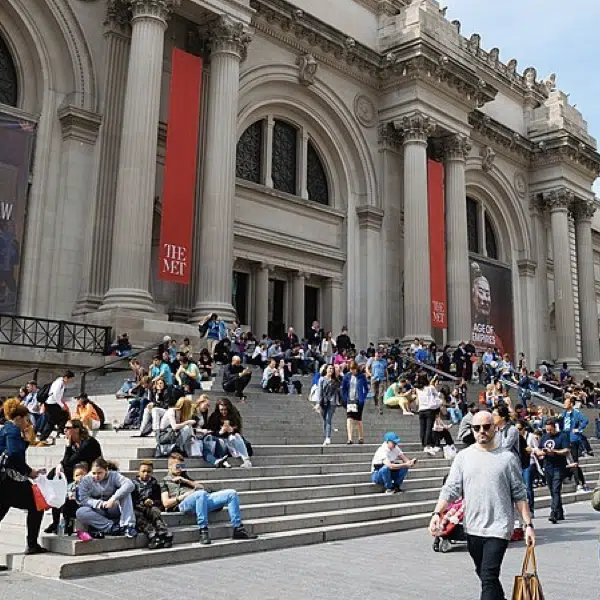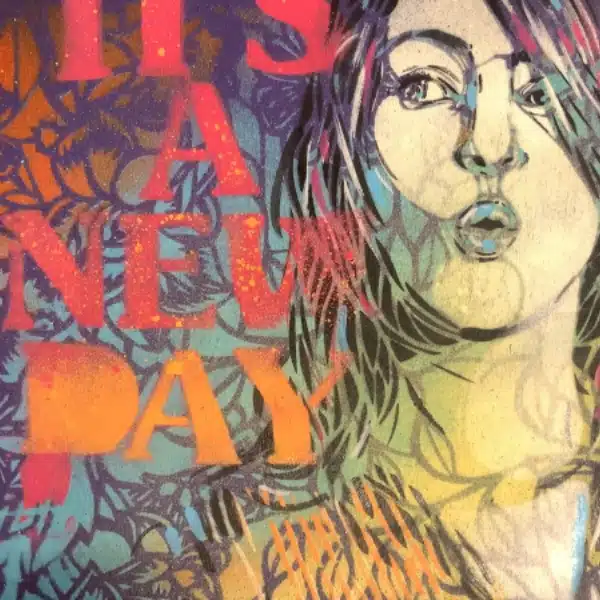The world's oldest champagne house, Ruinart, is well known for their creative collaborations with contemporary artists. The House of Ruinart was formed during the Enlightenment period, in 1729, and has since created a strong connection with the art world, commissioning well-known artists and supporting leading art fairs, like Art Basel. This year, French artist and scenographer Hubert Le Gall was chosen to create works that were symbolic of Ruinart's signature chardonnay, the Blanc de Blancs.
A visit to Ruinart's Sillery vineyard in the Reims area provided just the inspiration the artist needed to decide on what form his art would take. Hubert chose glass to express his vision of the House of Ruinart and then flew to Murano, Italy to find the master glassmakers who would bring his ideas, in the form of drawings, to life. The Berengo Studio was chosen because of their long history of working with contemporary artists.
A gorgeous series of 12 sculptures was created that was inspired by the vine. Hubert pays tribute to the passage of time showing the changing seasons through his work. “Man and nature are at the heart of this beautiful artistic story,” explains Ruinart.
First, here are some photos to show you the works in progress.





Now, displayed below are all of the 12 sculptures, each with its own rich and interesting story. While January's piece is minimalist, showing a vine covered with the soft whiteness of snow, May's is vibrant, revealing Spring's arrival with blossoming shoots. The golden bunches of grapes at the top of September's sculpture marks an important moment, the harvest, while December's piece reminds us of how nature comes full circle, with the vine returning to its roots.
 January – The sky is low and heavy. The vine is covered by a soft white coat of snow that accumulates at its feet. Nature is sleeping. In the cold light, a silhouette is making the most of this peace to prune the vine, a long, painstaking task which he is enjoying despite the biting cold.
January – The sky is low and heavy. The vine is covered by a soft white coat of snow that accumulates at its feet. Nature is sleeping. In the cold light, a silhouette is making the most of this peace to prune the vine, a long, painstaking task which he is enjoying despite the biting cold.
 February – The pruning continues in order to make the sap rise. This sap feeds the plant: the vine is weeping. Hubert has represented its tears with blue drops that defy the winter. The snow is transformed into an icy, gleaming coat. From time to time a ray of sunlight pierces the frost, casting its bright light onto the vine.
February – The pruning continues in order to make the sap rise. This sap feeds the plant: the vine is weeping. Hubert has represented its tears with blue drops that defy the winter. The snow is transformed into an icy, gleaming coat. From time to time a ray of sunlight pierces the frost, casting its bright light onto the vine.
 March – Man, ever present in the vineyard, prepares the vine's growth linking its branches and stalks. He guides it so that it will give the best of itself, preparing it to receive everything it will need for its development, in particular sun and water. Like a vessel, it is ready to receive the essence of life.
March – Man, ever present in the vineyard, prepares the vine's growth linking its branches and stalks. He guides it so that it will give the best of itself, preparing it to receive everything it will need for its development, in particular sun and water. Like a vessel, it is ready to receive the essence of life.
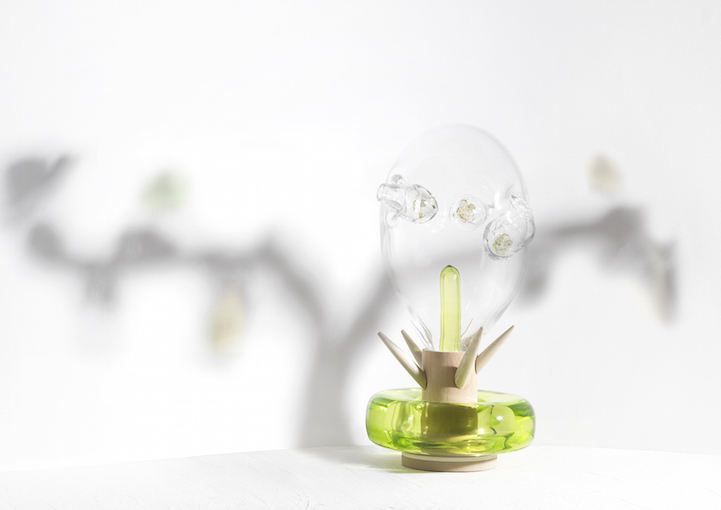 April – This work symbolizes the reassertion of life as the vine slowly emerges from winter. The buds begin to burst. A tender green color, the rising sap expands at the base of the vine. The buds swell, evoking the translucent beauty of new life.
April – This work symbolizes the reassertion of life as the vine slowly emerges from winter. The buds begin to burst. A tender green color, the rising sap expands at the base of the vine. The buds swell, evoking the translucent beauty of new life.
 May – The swallows have arrived and are circling happily in the sky. The days are lengthening as spring awakens and nature blossoms. The delicate shoots reveal the nascent bunches whose transparency and roundness already evoke the elegant finesse of Blanc de Blancs. The vine continues to hold itself back, however. Taking time is essential. The vineyard worker disbuds, discarding the shoots that have few or no grapes in order to retain only the very best.
May – The swallows have arrived and are circling happily in the sky. The days are lengthening as spring awakens and nature blossoms. The delicate shoots reveal the nascent bunches whose transparency and roundness already evoke the elegant finesse of Blanc de Blancs. The vine continues to hold itself back, however. Taking time is essential. The vineyard worker disbuds, discarding the shoots that have few or no grapes in order to retain only the very best.
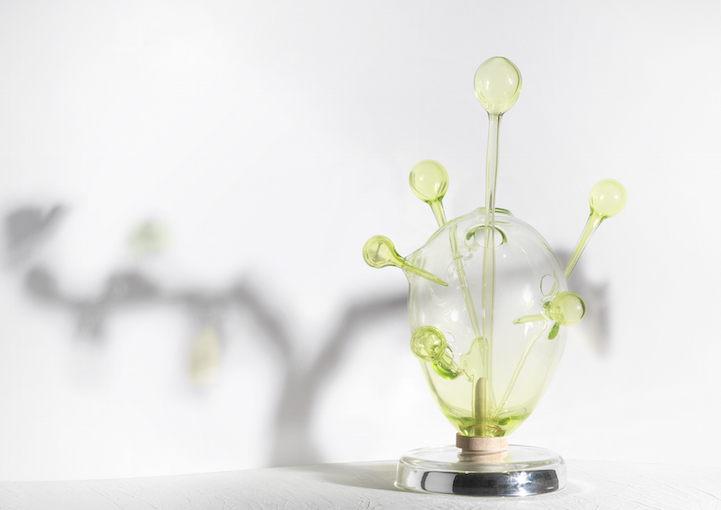 June – The time for flowering and development has arrived. The vine is exploding, its growth now accelerating, and it will need to be tamed and trained by man. The sun darts its rays at each plant, sparkling on the stones that cover the ground between the rows of vines; Hubert has conveyed the silver reflections that lend the vine its iridescence. The vine converses with its surroundings.
June – The time for flowering and development has arrived. The vine is exploding, its growth now accelerating, and it will need to be tamed and trained by man. The sun darts its rays at each plant, sparkling on the stones that cover the ground between the rows of vines; Hubert has conveyed the silver reflections that lend the vine its iridescence. The vine converses with its surroundings.
 July – The flowering gives way to the fruit set during which the flower is transformed into seeds. The vine is capped by a transparent yellow bell that envelops it like an incubator while the sun breathes life into it. The container at the base shows the extent to which the vine is opening up to receive everything it needs to nourish itself and develop.
July – The flowering gives way to the fruit set during which the flower is transformed into seeds. The vine is capped by a transparent yellow bell that envelops it like an incubator while the sun breathes life into it. The container at the base shows the extent to which the vine is opening up to receive everything it needs to nourish itself and develop.
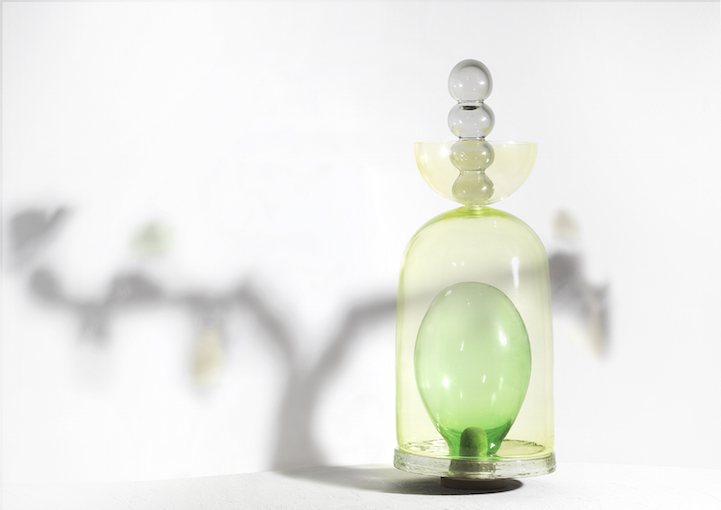 August – The wood of the vine has completely disappeared beneath the abundance of leaves and fruit. As far as the eye can see, green waves have spread across the slopes of Champagne. The seed is reaching maturity, attaining its full size and changing colour. Man remains very attentive. He places the vine under a bell like a reliquary, observing it carefully. These final moments before the harvest are absolutely crucial. The vine needs sun and water. These drops, so essential to its growth, are represented by the transparent spheres that crown the sculpture. The luminous yellow cup represents the sun and its beneficial effects.
August – The wood of the vine has completely disappeared beneath the abundance of leaves and fruit. As far as the eye can see, green waves have spread across the slopes of Champagne. The seed is reaching maturity, attaining its full size and changing colour. Man remains very attentive. He places the vine under a bell like a reliquary, observing it carefully. These final moments before the harvest are absolutely crucial. The vine needs sun and water. These drops, so essential to its growth, are represented by the transparent spheres that crown the sculpture. The luminous yellow cup represents the sun and its beneficial effects.
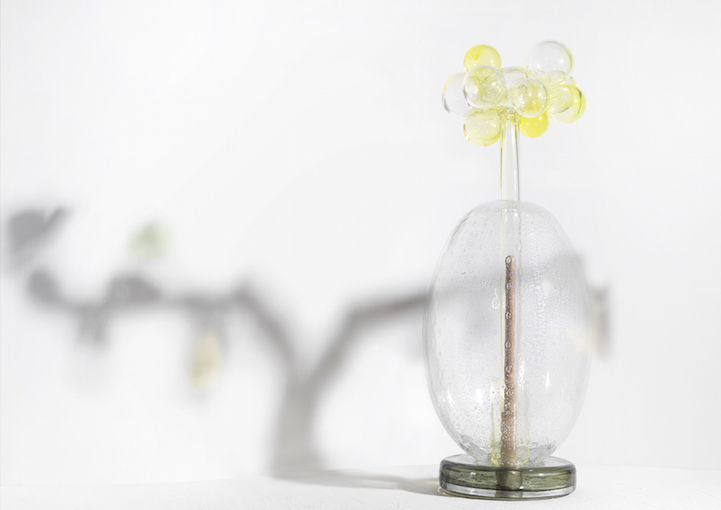 September – The long awaited moment has at last arrived: the harvest. Throughout the vineyard swarms of harvesters, like bees, are picking the grapes that will later become champagne. Juice flows from the fine golden bunches, already effervescent before it reaches the glass. Likewise is Hubert's work with his choice of glass dotted with small bubbles and whose transparency evokes that of Blanc de Blancs. It is topped by bubbles that suggest the sparkling wine dancing in the glass for our delight.
September – The long awaited moment has at last arrived: the harvest. Throughout the vineyard swarms of harvesters, like bees, are picking the grapes that will later become champagne. Juice flows from the fine golden bunches, already effervescent before it reaches the glass. Likewise is Hubert's work with his choice of glass dotted with small bubbles and whose transparency evokes that of Blanc de Blancs. It is topped by bubbles that suggest the sparkling wine dancing in the glass for our delight.
 October -The vine withdraws into itself, the leaves curling up and falling, revealing the wood once again. Man does not interfere. He observes the colors as they change from green to ochre.
October -The vine withdraws into itself, the leaves curling up and falling, revealing the wood once again. Man does not interfere. He observes the colors as they change from green to ochre.
 November – The movement towards the ground accelerates. Everything is falling, absorbed by the ground. The vine will be nourished by this providential fertilizer. The vineyard worker begins to shape the vine by pruning it.
November – The movement towards the ground accelerates. Everything is falling, absorbed by the ground. The vine will be nourished by this providential fertilizer. The vineyard worker begins to shape the vine by pruning it.
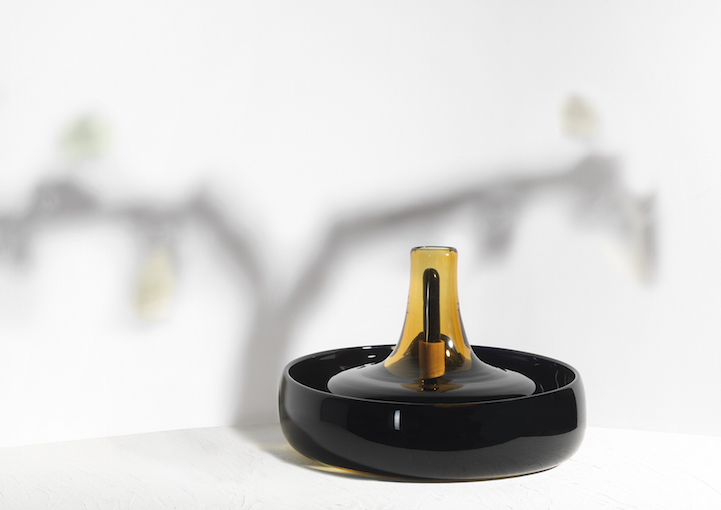 December – Time stands still. The vine is closing up like a box to hibernate. Everything darkens, losing its transparency. Each plant builds up its strength awaiting rebirth.
December – Time stands still. The vine is closing up like a box to hibernate. Everything darkens, losing its transparency. Each plant builds up its strength awaiting rebirth.
What a beautiful collaboration! Finally, make sure to watch video below to get a glimpse inside Hubert's creative process.


Learn more about Hubert Le Gall and his interpretation of Blanc de Blancs on the Ruinart website. You can follow Ruinart on Facebook and Instagram or have a conversation with their Cellar Master and Winemaker on Twitter.













































































